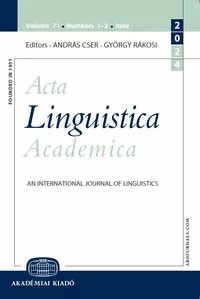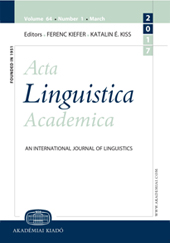Acta Linguistica Academica. An International Journal of Linguistics (Until 2016 Acta Linguistica Hungarica)
Acta Linguistica Academica. An International Journal of Linguistics (Until 2016 Acta Linguistica Hungarica)
Publishing House: Akadémiai Kiadó
Subject(s): Language studies, Philology
Frequency: 4 issues
Print ISSN: 2559-8201
Online-ISSN: 2560-1016
Status: Active
- 2017
- 2018
- 2019
- 2020
- 2021
- 2022
- 2023
- 2024
- 2025
- Issue No. 1/64
- Issue No. 2/64
- Issue No. 3/64
- Issue No. 4/64
- Issue No. 1/65
- Issue No. 2-3/65
- Issue No. 4/65
- Issue No. 1/66
- Issue No. 2/66
- Issue No. 3/66
- Issue No. 4/66
- Issue No. 1/67
- Issue No. 2/67
- Issue No. 3/67
- Issue No. 4/67
- Issue No. 1-2/68
- Issue No. 3/68
- Issue No. 4/68
- Issue No. 1/69
- Issue No. 2/69
- Issue No. 3/69
- Issue No. 4/69
- Issue No. 1/70
- Issue No. 2/70
- Issue No. 3/70
- Issue No. 4/70
- Issue No. 1-2/71
- Issue No. 3/71
- Issue No. 4/71
- Issue No. 1/72

- Year: 2025
- Volume: 72
- Number: 1
Special issue on vowel harmony
Articles list
Either templatic or harmonic
Either templatic or harmonic
(Either templatic or harmonic)
- Publication: (1/72/2025)
- Author(s): Péter Rebrus, Péter Szigetvári
- Contributor(s):
- Language: English
- Subject(s): Morphology
- Issue: 1/72/2025
- Page Range: 1-19
- No. of Pages: 19
- Keywords: phonological template; truncation; diminutives; frequentatives; vowel harmony; Hungarian
- Summary/Abstract: In addition to the common concatenative morphological system of Hungarian, there is a smaller portion of word forms that are templatic. These words satisfy requirements on their phonological shape. We here examine constraints on the number of syllables in templatic word forms. We observe that while the vowels in concatenative forms typically harmonize in backness (and in a more limited way also rounding), the vowels in nominal templatic forms often do not. On the other hand, the vowels in verbal templatic forms do harmonize. Furthermore, truncation is applied to satisfy the limit on word size in nominals, but truncation is generally not available as a repair for templatic verbal forms. We model our observations by a subsumption hierarchy of morphological layers: a concatenative layer, a (vowel) harmony layer, and a (stem) integrity layer.
A Neo-Jakobsonian merger of aperture, [−atr], lowering, emphaticness, and retroflexion
A Neo-Jakobsonian merger of aperture, [−atr], lowering, emphaticness, and retroflexion
(A Neo-Jakobsonian merger of aperture, [−atr], lowering, emphaticness, and retroflexion)
- Publication: (1/72/2025)
- Author(s): Markus A. Pöchtrager
- Contributor(s):
- Language: English
- Subject(s): Phonetics / Phonology
- Issue: 1/72/2025
- Page Range: 20-45
- No. of Pages: 26
- Keywords: atr; aperture; rhotics; retroflexes; emphatic consonants; structure
- Summary/Abstract: I argue that the system of Standard Yoruba vowels and their harmonic behaviour follow directly from the internal structure of vowels assumed in Government Phonology 2.0, a theory which reinterprets aperture (openness) as empty structure. I address a common connection between aperture and [−atr] and propose that while aperture is empty structure in general, [−atr] is a particular position within that empty structure. As a result, both Yoruba vowel harmony as well as other typical limitations of [−atr] (e.g. in high vowels) become derivable. What is more, the same reasoning (and the same solution) can be applied to the representation of consonants, in languages as diverse as French, Swedish, and Arabic, allowing me to unify (at least) aperture, [−atr], lowering, emphaticness, and retroflexion.
Patterns in Erzya suffixes: A case of vowel-consonant harmony
Patterns in Erzya suffixes: A case of vowel-consonant harmony
(Patterns in Erzya suffixes: A case of vowel-consonant harmony)
- Publication: (1/72/2025)
- Author(s): László Fejes
- Contributor(s):
- Language: English
- Subject(s): Phonetics / Phonology
- Issue: 1/72/2025
- Page Range: 46-69
- No. of Pages: 24
- Keywords: Erzya; vowel-consonant harmony; suffix alternation; sibilant palatalisation
- Summary/Abstract: This paper observes the regularities of Erzya vowel-consonant harmony through the alternations and lack of alternation in inflectional suffixes. Although Erzya harmony can apparently be analysed in an autosegmental framework as the progressive spreading of a unary feature for palatalisedness and frontness, there are phenomena which are problematic for such an analysis. These are the avoidance of the alternation of sibilants, the cases of regressive assimilation and the behaviour of the inversely alternating suffixes.
The vowels that almost harmonized: On Old Hungarian long vowels
The vowels that almost harmonized: On Old Hungarian long vowels
(The vowels that almost harmonized: On Old Hungarian long vowels)
- Publication: (1/72/2025)
- Author(s): András Cser, Beatrix Oszkó, Zsuzsa Várnai
- Contributor(s):
- Language: English
- Subject(s): Phonetics / Phonology, Historical Linguistics
- Issue: 1/72/2025
- Page Range: 70-81
- No. of Pages: 12
- Keywords: Old Hungarian; vowel harmony; grammaticalization; labial harmony
- Summary/Abstract: While in Modern Hungarian labial harmony is confined to short front non-high vowels, in Late Old Hungarian some suffixes including non-high long vowels were also able to undergo labial harmony. This paper discusses three of the most widely attested suffixes in question, the ablative, the delative and the elative nominal case suffixes. All the three suffixes were originally grammaticalized from case-marked nouns; their participation in both backness and labial harmony followed on their integration into the morphological structure of host nouns. Their ability to undergo labial harmony was subsequently lost. An explanation is proposed for why they stopped harmonizing in labiality, based partly on the phonological parameters of variation extant in Late Old Hungarian, partly on homophony avoidance in the changing paradigmatic space of the case system.
Short Description
Acta Linguistica Academica publishes papers on general linguistics. Papers presenting empirical material must have strong theoretical implications. The scope of the journal is not restricted to the core areas of linguistics; it also covers areas such as socio- and psycholinguistics, neurolinguistics, discourse analysis, the philosophy of language, language typology, and formal semantics. The journal also publishes book and dissertation reviews and advertisements.

